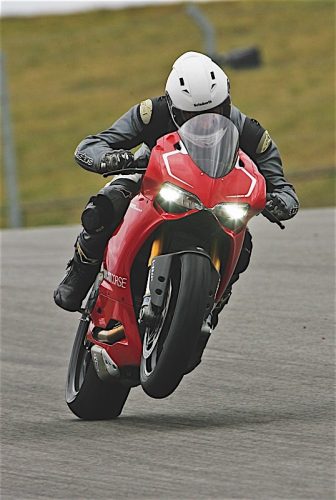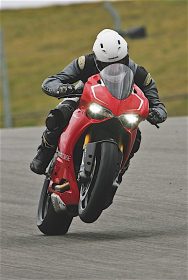Recent test rides on some high-power supersport machines got me thinking about horsepower and torque. The latest BMW S1000RR and Yamaha R1 each claim to produce close to 200 hp, and the Ducati 1299 Panigale claims 205. Although those numbers are very close, the Ducati pulls incredibly hard, almost violently, and from relatively low revs compared with the two four-cylinder machines.
 It’s when digging deeper into the specs that the reason for this is revealed. While the BMW and Yamaha produce 83 ft-lb of peak torque at 10,500 rpm and 11,500 rpm, respectively, the Ducati makes 106 ft-lb of peak torque at 8750 rpm. And it’s this massive peak torque at lower revs that makes the Ducati accelerate like a bomb went off behind it.
It’s when digging deeper into the specs that the reason for this is revealed. While the BMW and Yamaha produce 83 ft-lb of peak torque at 10,500 rpm and 11,500 rpm, respectively, the Ducati makes 106 ft-lb of peak torque at 8750 rpm. And it’s this massive peak torque at lower revs that makes the Ducati accelerate like a bomb went off behind it.
Think of horsepower as the amount of work you perform over a period of time; think of torque as how hard you work over the same period. Horsepower is a unit of measurement for power output. Although there are several, slightly varying versions of horsepower (European PS, mechanical horsepower, metric horsepower), each unit of horsepower represents a similar amount of work. The most common measurement used in North America is mechanical horsepower, where 1 hp is the equivalent of the power needed to lift 33,000 pounds one foot in one minute, or 550 pounds one foot in one second, or 745 watts. For comparison, one metric horsepower is the equivalent of the power needed to lift 75 kg one metre in one second, or 735 watts.
The numbers for mechanical horsepower were determined by Scottish mechanical engineer James Watt, who developed the concept of horsepower in the 18th century to sell steam engines to farmers who used horses to do the majority of work on their farms. Watt had observed that a (rather strong) horse could turn a 24-foot-diameter mill wheel with about 180 lb of force at a rate of about two and a half times per minute.
Torque is the amount of twisting force applied at the axis of a shaft, measured in foot-pounds or pound-feet. One foot-pound of torque (1 ft-lb) is the equivalent of the twisting force applied at the pivoting end of a lever when one pound of force is applied at the end of a lever that is one foot long. If that lever were two feet long, but the same amount of force was applied at the end, you would get two foot-pounds of twisting torque at the pivoting end, and so on.
 So torque is the actual force being applied at the rear wheel of your bike, and horsepower is a measure of the amount of work your bike can perform over a period of time. Work in this instance would equal distance, but includes the total weight of the bike and rider. The more torque that is applied to the wheel, the more weight the bike can move over a distance; or with weight remaining fixed, the faster the bike will accelerate.
So torque is the actual force being applied at the rear wheel of your bike, and horsepower is a measure of the amount of work your bike can perform over a period of time. Work in this instance would equal distance, but includes the total weight of the bike and rider. The more torque that is applied to the wheel, the more weight the bike can move over a distance; or with weight remaining fixed, the faster the bike will accelerate.
There are two basic variables affecting the torque being applied to the rear wheel of your bike: gearing and engine stroke. More torque is available in lower gears, which is why the bike pulls harder and accelerates more quickly in first through third gears, though the trade-off is top speed. The mechanical ratio offered in the lower gears would be the equivalent of lengthening the lever discussed earlier; stretching it to 10 feet long while applying one pound of pressure at the end would equal 10 ft-lb of twisting force, but the amount the pivoting end would move for a given travel at the other end would be greatly reduced; thus the reduced speed.
The same mechanical advantage is available at the source of the power: the crankshaft. A crankshaft is essentially a lever, with the pivot point attached to the flywheel, and the force being applied at the other end, the crankpin, which is connected to the piston via a connecting rod. The distance between the pivoting point of the crank and the crankpin when doubled is the stroke. All other engine factors remaining the same, increasing this distance will increase the leverage ratio of the piston on the pivoting point, or flywheel, and thus increase the amount of available torque, although it will reduce the potential for high speed.
This is why lower revving long-stroke engines (read V-twin cruisers) have a meaty bottom end and can carry passengers and luggage effortlessly, at least from a power perspective, and why short-stroke multi-cylinder engines (read sport bikes) have the potential for higher top speeds. Please keep in mind that this is an overly simplified explanation, as a detailed analysis with the required mathematical formulas would take volumes to explain.
But one thing to note is that for a given measured horsepower, say about 200 hp, the higher the torque output, the more force that is available at the rear wheel, and in the Ducati Panigale, that extra torque is a result of more displacement, but mostly because of its longer-stroke crankshaft.
Technical articles are written purely as reference only and your motorcycle may require different procedures. You should be mechanically inclined to carry out your own maintenance and we recommend you contact your mechanic prior to performing any type of work on your bike.












